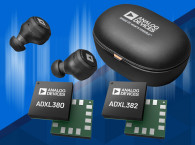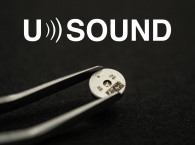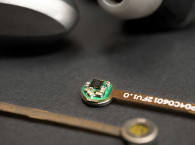
USound’s current MEMS microspeaker generation already offers more than 50% extended battery life for wireless earbuds compared to systems with electro-dynamic speakers. The soon to be available next-generation devices will integrate an innovative energy recovery audio amplifier that USound states will create the most advanced and compact micro audio system on the market. "It will remarkably cutback the power consumption of the device allowing up to 12 hours of battery life for applications like true wireless earbuds and other wearable devices," they state.
USound's MEMS microspeakers not only decrease dramatically the audio system’s power consumption, but also grants diminishing the diameter and weight of the housing of any wearable due to its reduced size, potentially gaining in comfort and ergonomics for the end consumer. As a result of its design, its production can be fully automated, cutting costs in manufacturing.
USound MEMS silicon microspeakers technology is based on a membrane mounted on a number of cantilevers built from PZT (lead zirconate titanate). When voltage is applied to this material, the crystals in the PZT expand or shrink making the membrane vibrate. Multiple cantilevers create a translation of the extension and shrinking, pushing a piston up and down. This replaces the traditional coil moving in a magnetic field as found in conventional speakers. Finally, mounting a membrane and a plate closes the acoustic shortcut and increases the effective area, thus enabling extended bandwidth sound generation.

With this approach, less heat is produced as well as less sound distortions due to fewer moving parts, creating an overall more robust system – in contrast to conventional speaker systems. With its powerful and efficient piezo-actuators, MEMS speakers can be as thin as 1 mm and shrunk to a footprint as small as 3*3 mm. Furthermore, USound’s transducers are fully integrated solutions, supporting additional functions such as voice fingerprint, inherent microphone functionality and ADCs.
"Due to its versatile mechanical and electrical properties, silicon has taken over the microelectronic and micromechanical worlds. Thanks to CMOS (Complementary Metal Oxide Semiconductor) and MEMS (Micro ElectroMechanical Systems) technologies yielded by this material, electronic devices can interact with our surroundings. This combination has created product categories such as smartphones and wearables, which would have belonged to science-fiction thirty years ago," the company states.

USound hopes to enable the market transition from electrodynamic drivers to solid-state technology and that products such as its Ganymede piezoelectric MEMS will have a market effect similar to LED technology. USound’s MEMS microspeakers are shock resistant, can be individually adapted to the working environment and boast peak and overdrive control. Multiple drivers can also be integrated in very-small volumes.
USound MEMS microspeakers are now available through Digi-key. USound’s micro audio systems, including its energy recovery audio amplifier, will be available by Q3 2019.
www.usound.com






